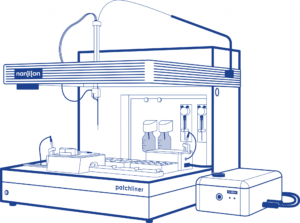
Patchliner
The Patchliner is versatile yet robust, ideal for basic research of ion channel biophysics and mechanisms of action, sophisticated assays such as heat activation, right through to routine assays such as safety screening of hERG or other cardiac ion channels in accordance with the CiPA initiative. The Patchliner is a medium throughput automated patch clamp system which comes as a 4 or 8 channel version. Experimental protocols are programmed using the PatchControlHT software which controls the Tecan robot for addition of solutions, cells and compounds, and controls the PatchMaster software for data acquisition. NPC-16 chips, the consumable for the Patchliner, can be loaded on the chip wagon and the instrument can run unattended for 48 recordings. The Patchliner is supplied as a complete system including Tecan pipetting robot, HEKA EPC10 amplifiers, NPC-16 chips, Reagent starter kit and all the required software. Add-ons for Temperature control, Cooled CellHotel and dynamic clamp (Dynamite8) are also available to expand the experimental possibilities. Our dedicated team of electrophysiologists and engineers are committed to continuous in-house assay development, software and hardware advancements, ensuring fast and custom-tailored solutions for your assay demands.

SyncroPatch 384
The SyncroPatch 384 is an automated patch clamp instrument with 384 recording channels incorporated into a state-of-art liquid handling robot. It can be used for screening large compound libraries but also for smaller screens and assay development using the 32-well mode of operation. This allows the instrument to be literally turned into a lower throughput instrument, using a fraction of the chip and pipetting head in multiples of 32 wells. The rest of the chip can be used over several days which takes further advantage of the economical price of the NPC-384 chip. The SyncroPatch 384 also includes a sophisticated temperature control which can cool as well as heat, this can be used to maintain a constant temperature or to activate cold-activated ion channels. The SyncroPatch 384 can be used in all stages of drug discovery, from hit discovery through lead optimization to safety pharmacology, and can also be used for complex biophysical analysis of ion channels in academic research. The SyncroPatch 384 is supplied as a complete system including the Biomek i5 pipetting robot, Tecella amplifier with 384 channels, NPC-384 chips, Reagent starter kit and all the required software. Temperature control, Cooled CellHotel and current clamp are all provided as standard.
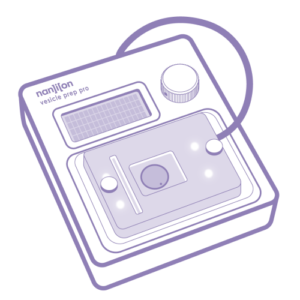
Vesicle Prep Pro
The Vesicle Prep Pro is the first product on the market for automated preparation of solvent-free giant unilamellar vesicles (GUVs). The Vesicle Prep Pro has been designed to keep the preparation process simple and, ensure stable and reproducible results. The Vesicle Prep Pro offers a simple platform to generate reproducible and reliable GUVs by means of electro-swelling. The chamber in which the GUVs are made is formed by ITO-coated glass cover slides so that vesicle formation can be monitored using a microscope. Integrated features, including flexible protocol design and temperature control, allow generation of GUVs from a wide variety of lipids, e.g., lipids with high charge or high phase transition temperatures.

SURFE²R N1
The technology employs solid supported membrane (SSM) -based electrophysiology which was established in the late 1990s. The reusable sensors contain a gold-coating on which the SSM is formed in a quick pipetting process. Then the sample containing your transporter of interest is added on top to physically adsorb to the SSM. Any kind of membrane preparation containing the protein of interest can be used for measurements, e.g. membrane vesicles after cell disruption or proteoliposomes after reconstitution of purified proteins. These samples can be stored frozen for months and years. Therefore no running cell culture lab is required. The key to SSM-based electrophysiology is the exchange of solutions to provide the substrate or ligand and activate the transporter. The following charge translocation is detected and can be analyzed. Due to the high stability of the SSM up to one hundred sequential measurements can be performed on the same sample. This allows for determination of parameters such as EC50 or IC50. Since the time resolution of solution exchange is state-of-the-art, not only slow transport can be measured, but also fast binding reactions can be assayed and rate constants can be determined.

SURFE²R 96SE
Just like the SURFE2R N1, the SURFE2R 96SE employs solid supported membrane (SSM)-based electrophysiology to resolve small currents of transporters and pumps but elevates the throughput to the next level by parallelization of 96 measurements. The transporter samples are added to gold-coated sensors in a standard 96 well-plate format. To further reduce the user's workload, most sensor coating steps can be done by the SURFE2R 96SE itself. Any substrate can be added to activate the transporter. The resulting transport or binding currents will be detected and analyzed accordingly. The process from sensor preparation and measurement to data analysis is fully automated. The SURFE2R 96SE is preferred over the SURFE2R N1 when a high throughput environment is needed. This is the case, e.g. for compound or transporter screening projects. The SURFE2R 96SE is also suitable to increase throughput for basic research. Data generation is approximately 100 times faster compared to the SURFE2R N1.
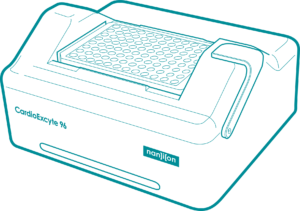
CardioExcyte 96
With embedded electronics and sophisticated sensor technology integrated into the well-plate-based consumables, the CardioExcyte 96 is a turn-key system for efficient impedance and extracellular field potential measurements. The CardioExcyte 96 package includes an Incubation System which makes the system independent of an incubator. The system is placed on the bench top with maintained control over temperature, gas mix, and humidity. Efficiency and ease of use are facilitated by an outstanding software package for data handling and export - an essential part of the CardioExcyte 96 system. The system has been validated with stem cell-derived cardiomyocytes from all major stem cell providers, as monolayers or beating 3D-clusters, as well as with cell lines (hepatocyte-like cells, cancer cells, etc.) for cytotoxicity studies.
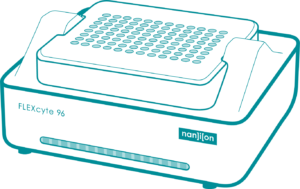
FLEXcyte 96
The FLEXcyte 96 brings in vitro contraction force measurements of cardiac cells to a new dimension. By using a well-defined, flexible substrate for cardiac cells, the system leverages maturity and mature responses of stem cell-derived cardiomyocytes to pharmacological compounds in a higher throughput format. In the 96-well plate, the cells adhere as monolayers on the flexible substrates and the contractility of the synchronized cell layers is recorded. This unique technology allows for recordings in a native-like environment close to the mechanical conditions of the heart. The FLEXcyte 96 is a turn-key system for structural and functional contraction force recordings in cardiotoxicity, safety and efficacy screening, and basic research. With less than 10 μm in thickness and sophisticated surface modification, the polydimethylsiloxane (PDMS) membranes of the FLEXcyte 96 disposable plates offer physiological elasticity of native human heart tissue and strong mechanical support. While being deflected by the weight of the culture medium, rhythmic contraction of the cardiomyocytes lifts the membranes in the 96-well upwards. By measuring the changes in deflection, mechanical stress can be calculated. The system has been validated with stem cell-derived cardiomyocytes from several providers (Ncardia, FUJIFILM Cellular Dynamics, Inc. (FCDI), Axol and NEXEL). Human induced pluripotent stem cell-derived cardiomyocytes (hiPSC- CMs) display positive inotropic responses, no additional stimulation of “cell maturation” is necessary. Cardiac contraction force can also be measured on patient-derived cells. No subtleties of cytotoxic responses are missed, and measuring contractile forces (mN/mm2) on heart muscle cells for safety, efficacy, and toxicity investigations in both chronic and acute time frames are performed reliably. The FLEXcyte 96 is a fully automated device, records from 96 wells in parallel.
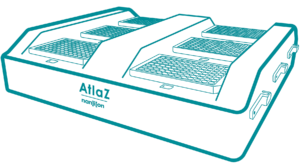
AtlaZ
The AtlaZ brings in vitro cell analytics to a new dimension. It is an advanced system designed for quantitative live-cell analysis. It provides researchers with the capability to investigate various cellular aspects, including cell adhesion and proliferation, cytotoxicity, GPCR (G-protein coupled receptor) signaling, morphology, and barrier function in real-time. Importantly, these measurements are label-free, eliminating the need for external dyes or markers. With the AtlaZ system, recordings can be conducted simultaneously or independently in up to six 96-well plates. This high throughput capability, combined with the underlying methodology of powerful electrical impedance spectroscopy (EIS), offers researchers valuable insights into cellular behavior and responses on a scale that was previously unattainable. AtlaZ measures and analyzes the electrical impedance parameters across a range of frequencies (from 0.1 kHz – 100 kHz), such as impedance magnitude and phase, resistance, and capacitance. A crucial advantage over standard assays using labels or dyes, is the continuity of cell monitoring. Endpoint assays are labor-intensive and lack kinetic information of the recorded effects. AtlaZ uses unique culture plates with integrated electrodes which enable long-term measurements over several weeks. Thus real-time data on cell adhesion, proliferation and compound effects can be acquired. Ready-to-go Recording Modes with automated graphing of results are available for ease-of-use, while running a full spectrum provides understanding about various cellular mechanisms, such as cell death.
Want to know more?
Do you wish to reach out for more information or see how we can help you? Reach out to us by clicking the button below!

